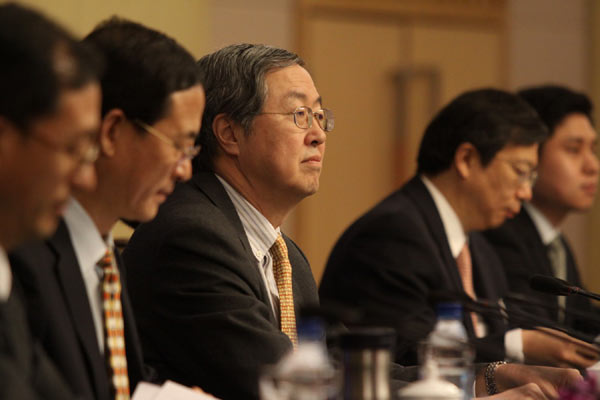Zhou Xiaochuan (3rd L), governor of the People's Bank of China (PBOC), the country's central bank, Hu Xiaolian, deputy governor of PBOC, Liu Shiyu, deputy governor of PBOC, and Yi Gang, deputy governor of PBOC and head of the State Administration of Foreign Exchange hold a news conference on monetary policies and financial reforms in Beijing on Monday. [Photo by Jiang Dong/chinadaily.com.cn]

BEIJING - A trade deficit in the first two months of this year, as well as its impact on the exchange rate of the Renminbi in the foreign exchange market, is "a good thing" for China, the governor of China's central bank said Monday.
The supply-and-demand relation in the market is playing an increasing role in deciding the exchange rate of the Chinese currency, Zhou Xiaochuan, governor of the People's Bank of China (PBOC), said at a press conference on the sidelines of the ongoing annual parliamentary session.
China hit a trade deficit of 31.48 billion US dollars in February, marking the largest trade deficit in a decade as import growth far outpaced exports, according to customs data.
The country's combined trade deficit reached 4.25 billion US dollars in the January-February period after offsetting a trade surplus of 27.28 billion US dollars in January.
"We need to take a longer period of time to see whether China's foreign trade will be balanced or not this year," Zhou said.
Yi Gang, vice governor of the PBOC and head of the State Administration of Foreign Exchange (SAFE), also described the trade deficit in February as a "positive sign" of a more even international balance of payment for China.
Yi told the press conference that China has made "remarkable achievements" in reducing the trade surplus, promoting more balanced foreign trade, expanding domestic demand and furthering economic restructuring.
The chief foreign exchange regulator said since the fourth quarter of 2011, the domestic spot and futures market, as well as the non-deliverable forward offshore market, have expected the Renminbi's exchange rate to fluctuate in a two-way manner rather than just the single-direction of appreciation that was anticipated in the past.
Yi vowed to continue to improve the yuan's exchange formation mechanism and boost the flexibility of the yuan's two-way fluctuation due to more mature conditions created by China's international balance of payment and market expectations.
However, Yi said no one could tell the exact balanced point of the yuan's exchange rate, as it would be decided by the supply-and-demand relation in the market.
China will continue the market-based reform of the yuan's exchange rate formation mechanism and let the market play a greater role in the process to help with more balanced international payment and a more sustainable economy, Yi added.
